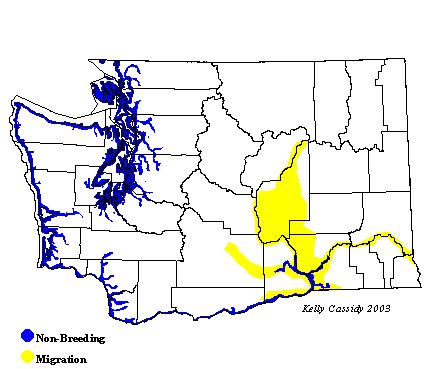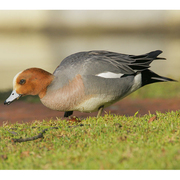Eurasian Wigeon
General Description
This winter visitor from Siberia is a close relative of the American Wigeon. The male Eurasian Wigeon in breeding plumage has a salmon-colored breast, pale gray body, and black undertail coverts. His head is dark rufous with a yellowish forehead. The wing has a green speculum with white coverts (the white is absent on the female), much like the American Wigeon. Juveniles and males in eclipse plumage (from July to September) look like the female. Female Eurasian and American Wigeons appear very similar, but the female Eurasian lacks the black border at the base of the bill. The main features that distinguish the Eurasian Wigeon from the American Wigeon are the gray sides and the russet face-markings. The Eurasian Wigeon hybridizes occasionally with the American Wigeon, and these birds, which show a mixture of characteristics, are seen in Washington with regularity.
Habitat
Eurasian Wigeons inhabit marshes, lakes, bays, and fields.
Behavior
In North America, Eurasian Wigeons are almost always found in flocks of American Wigeons. The foraging strategies of the Eurasian Wigeon include picking food from the surface of shallow water, grazing in upland areas, and feeding on vegetation brought up by coots and diving ducks.
Diet
Leaves, stems, roots, and seeds make up the bulk of the diet. Insects are also taken in the summer.
Nesting
Eurasian Wigeons are known to breed only in Europe and Asia, although they are likely to be found breeding in North America eventually. They nest on the ground under dense vegetation, usually near water. The nest is a shallow depression lined with grass and down. The female incubates 8 to 9 eggs for 24 to 25 days. The young leave the nest and head for water shortly after hatching. They find their own food, although the female continues to tend them until they fledge at 40 to 45 days.
Migration Status
Eurasian Wigeons are known to breed only in Europe and Asia, although they are likely to be found breeding in North America eventually. They nest on the ground under dense vegetation, usually near water. The nest is a shallow depression lined with grass and down. The female incubates 8 to 9 eggs for 24 to 25 days. The young leave the nest and head for water shortly after hatching. They find their own food, although the female continues to tend them until they fledge at 40 to 45 days.
Conservation Status
Numbers of Eurasian Wigeons reported in North America have increased in recent decades, which may be due to increased reporting, or to an actual increase of birds. It is possible they are breeding at an unknown site somewhere in North America. Hybrids of Eurasian Wigeons and American Wigeons have been recorded.
When and Where to Find in Washington
The Eurasian Wigeon is a regular winter visitor to Washington's coasts and western lowlands. Many large flocks of wintering American Wigeons contain at least one Eurasian. They are also found less commonly in eastern Washington during migration and winter.
 Abundance
Abundance
| Ecoregion | Jan | Feb | Mar | Apr | May | Jun | Jul | Aug | Sep | Oct | Nov | Dec |
|---|---|---|---|---|---|---|---|---|---|---|---|---|
| Oceanic | ||||||||||||
| Pacific Northwest Coast | U | U | U | R | R | U | U | U | ||||
| Puget Trough | U | U | U | U | R | R | U | U | U | |||
| North Cascades | ||||||||||||
| West Cascades | U | U | U | R | U | U | U | |||||
| East Cascades | R | R | R | R | R | R | ||||||
| Okanogan | ||||||||||||
| Canadian Rockies | R | R | ||||||||||
| Blue Mountains | ||||||||||||
| Columbia Plateau | U | U | U | R | U | U | U |
Washington Range Map

Family Members
 Fulvous Whistling-DuckDendrocygna bicolor
Fulvous Whistling-DuckDendrocygna bicolor Taiga Bean-GooseAnser fabalis
Taiga Bean-GooseAnser fabalis Greater White-fronted GooseAnser albifrons
Greater White-fronted GooseAnser albifrons Emperor GooseChen canagica
Emperor GooseChen canagica Snow GooseChen caerulescens
Snow GooseChen caerulescens Ross's GooseChen rossii
Ross's GooseChen rossii BrantBranta bernicla
BrantBranta bernicla Cackling GooseBranta hutchinsii
Cackling GooseBranta hutchinsii Canada GooseBranta canadensis
Canada GooseBranta canadensis Mute SwanCygnus olor
Mute SwanCygnus olor Trumpeter SwanCygnus buccinator
Trumpeter SwanCygnus buccinator Tundra SwanCygnus columbianus
Tundra SwanCygnus columbianus Wood DuckAix sponsa
Wood DuckAix sponsa GadwallAnas strepera
GadwallAnas strepera Falcated DuckAnas falcata
Falcated DuckAnas falcata Eurasian WigeonAnas penelope
Eurasian WigeonAnas penelope American WigeonAnas americana
American WigeonAnas americana American Black DuckAnas rubripes
American Black DuckAnas rubripes MallardAnas platyrhynchos
MallardAnas platyrhynchos Blue-winged TealAnas discors
Blue-winged TealAnas discors Cinnamon TealAnas cyanoptera
Cinnamon TealAnas cyanoptera Northern ShovelerAnas clypeata
Northern ShovelerAnas clypeata Northern PintailAnas acuta
Northern PintailAnas acuta GarganeyAnas querquedula
GarganeyAnas querquedula Baikal TealAnas formosa
Baikal TealAnas formosa Green-winged TealAnas crecca
Green-winged TealAnas crecca CanvasbackAythya valisineria
CanvasbackAythya valisineria RedheadAythya americana
RedheadAythya americana Ring-necked DuckAythya collaris
Ring-necked DuckAythya collaris Tufted DuckAythya fuligula
Tufted DuckAythya fuligula Greater ScaupAythya marila
Greater ScaupAythya marila Lesser ScaupAythya affinis
Lesser ScaupAythya affinis Steller's EiderPolysticta stelleri
Steller's EiderPolysticta stelleri King EiderSomateria spectabilis
King EiderSomateria spectabilis Common EiderSomateria mollissima
Common EiderSomateria mollissima Harlequin DuckHistrionicus histrionicus
Harlequin DuckHistrionicus histrionicus Surf ScoterMelanitta perspicillata
Surf ScoterMelanitta perspicillata White-winged ScoterMelanitta fusca
White-winged ScoterMelanitta fusca Black ScoterMelanitta nigra
Black ScoterMelanitta nigra Long-tailed DuckClangula hyemalis
Long-tailed DuckClangula hyemalis BuffleheadBucephala albeola
BuffleheadBucephala albeola Common GoldeneyeBucephala clangula
Common GoldeneyeBucephala clangula Barrow's GoldeneyeBucephala islandica
Barrow's GoldeneyeBucephala islandica SmewMergellus albellus
SmewMergellus albellus Hooded MerganserLophodytes cucullatus
Hooded MerganserLophodytes cucullatus Common MerganserMergus merganser
Common MerganserMergus merganser Red-breasted MerganserMergus serrator
Red-breasted MerganserMergus serrator Ruddy DuckOxyura jamaicensis
Ruddy DuckOxyura jamaicensis

